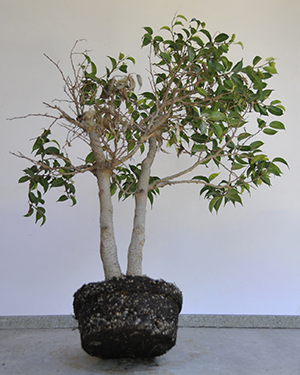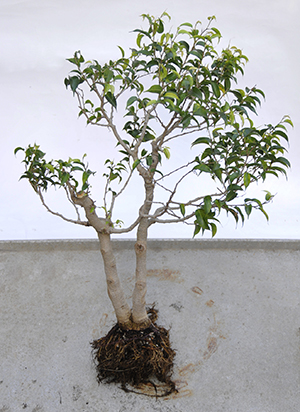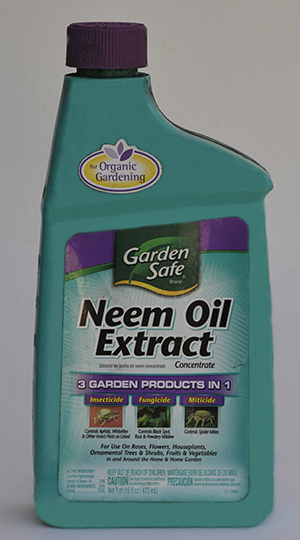Hints and Teasers
Bonsai Basics: Meanderings of an Old Man
By Lew Buller
Sun, Water, Flowers, Fertilizer, Soil, Stones, Pest and Disease
Sun
Trees grown in shade require more chlorophyll to capture the same amount of energy from the sun as their counterparts grown in sun. The result is that the leaves are a deeper green. This applies to junipers as well as it does to the privet leaves shown here. The difference is not so visible in the top surfaces of the leaves, but the bottom surfaces clearly show the effect of the sun.
Experiment for yourself. For show purposes, you may want the deeper blue-green color shade brings to junipers. Other species, like the Chinese hackberry, have thin leaves that burn in the sun but also turn a darker green in full or even partial shade.
Water
More trees are killed by over watering than by under watering. This was brought home to me this spring when San Diego had an unusual amount of rain. I continued to check for dryness before watering after a rain, but failed in a basic of bonsai–rotate the trees regularly. The side facing the morning sun dried out; the side away from the sun did not. Since the trees showing the most problem were ficus benjamina “Little Lucy,” I wasn’t worried because they regularly survive cycles of monsoons and droughts in their countries of origin.
Not until the leaves and branches on the back side of the plants started dying did I suspect anything. Following my habit of examining the roots when there is a problem with the foliage, I took one out of the pot. Here are photos of the second one I took out of the pot. A twin trunk, the back trunk was dying, including the roots on the back side. I trimmed everything severely, washed as much old soil off as was possible, and repotted it in fresh, good-draining soil. The back side is now facing the sun, and I may not rotate the tree until it shows signs of new growth.
A word on design: With twin trunk bonsai, the trunks should begin at soil level. The taller of the two trunks should be potted in a vertical position.
My motto is “Never throw anything away.” I kept air layers, cuttings, and mother plants until a major part of my collection was “Little Lucy.” My job now is to reduce my collection of trees until I can give each one the care it deserves.
Flowers
The one time not to underwater is when a plant is flowering. It will cause the flowers to droop and fall. It is not necessary to overwater, but rather regular watering is called for. To some extent, flowering can be controlled by not watering before flowering is due to start. Under stress, plants try to reproduce and flowering is the first step. Bougainvillea flower over a long period of time, so if flowering can be induced early, the trees can be shown in bloom. For example, it is March 23, 2015 and this Rosenka will still be flowering on April 25, 2015 when the local club has its annual spring show. During the prior year, the plant was well fertilized with a broad spectrum fertilizer having high phosphorus content. It got spring rains, but relatively little water from me. Be careful with this approach.
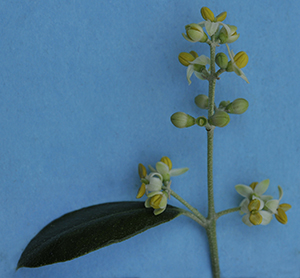
Different trees have different requirements for flowering. Olives, for example, prefer a cold winter so the California olive industry developed in the northern part of the state. Cultivars were developed that bear flowers and fruit in the southern part, but my olive still prefers a cold snap for blooming and fruiting. San Diego had one in the winter of 2014-2015 with the result that one of my olives flowered and may bear drupes later in the year.
Fertilizer
Richard Ota, an outstanding California Bonsai artist, said he “was crazy about azaleas for ten years.” He also said the growth pattern of azaleas is opposite that of black pines. Azaleas developed in the vicinity of black pines, growing in the acidic mulch created by the rotting of black pine needles. Acidic? A pH of 4 on a scale in which a pH of 7 is neutral. The pines also created shade. In Japan, surrounded on all sides by ocean, high humidity reduced the need for watering.
Lessons learned the hard way: An elderly club member took an azalea workshop and paid $165 for a well-developed azalea imported from Japan. After it grew a while, she decided to fertilize it using the same foliar spray as she used on her other plants. She killed it, as azaleas cannot stand having anything except water on their leaves. They also tolerate only very limited fertilizing, having developed in sparse soil.
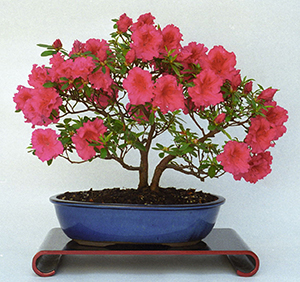
My azalea had grown in the ground under shade in the high humidity in La Jolla, California. I dug it out of the ground there, with the permission of a client, and grew it on in the shady part of my back yard. As you look at the photo, you can see the trunks are very small compared to the foliage and flowers they support. I knew you could cut all the branches from an azalea and they would grow new ones, so I proceeded to cut them off. Sure enough, the azalea popped new growth. The mistake? I fertilized it with a slow-release organic fertilizer but even that was too much–it killed the plant.
Having pointed out some of the difficulties of growing azaleas, I can go on to say that if you like flowering plants, perhaps you should try azaleas. If you live in a moderate climate with some humidity, have shade, can create a free-draining acidic soil (use peat or Kanuma), and have enough patience to develop a tree over a long period of time, then you may want to try azaleas.
You can find information on azalea bonsai on the Internet, including video presentations and interestingly enough, an advertisement for azalea bonsai at Walmart, San Diego, CA. Pick your references carefully. Get Japanese material if possible. A last warning: do not cut branches off close to the trunk. Azaleas have thin bark, and heal very slowly. Wiring can be difficult.
Soil
One size does not fit all. Learn to use the basic bonsai soil for the area in which you live. Join a club, knowing you will get some basic information and a lot of socializing. As you begin to try trees outside your local growing area, you may find it necessary to modify acidity, drainage characteristics, amount of humus to use in the mix, other additives such as fir bark, and particle size.
A word of caution: don’t change to new soil mixes on all your plants at once; try the new mix on a few at a time until you see the results.
Stones
In addition to serving as accessories in a bonsai display, stones may be an integral part of the bonsai. They may be used to disguise a defective root base (nebari) or they may be part of a forest display, added to create a realistic forest scene. In either case, the stone should appear to have roots in the soil. This can be accomplished by burying the stone in soil 40 % to 60% of its height. In a forest scene, the stone can buried easily. If ever there was a stone that looked as if it had roots, this one does.

The San Jose cascade clearly could stand some cover for its large bare-root area. A 5-inch stone does the trick. Small grasses might help, also.
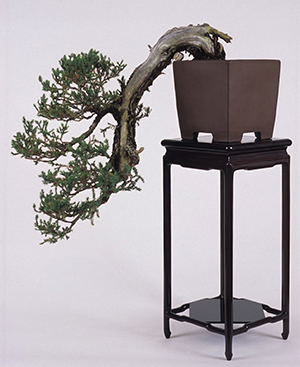

The two Jackson brothers and some friends took me stone hunting in the Lake Hill area of the Mojave (now closed to the public) and introduced me to a new type of stone called a “Leaverite.” If a stone had no real potential for display, instructions were to “Leaverite there.”
Pests and Diseases
In the past year, 2014, I have lost more bonsai due to what I believe is an unidentified fungus that came from warmer climates than I have lost in my entire bonsai-growing career. It thrives in full hot sun and I can only control it slightly by putting junipers in shade.
The insecticides and fungicides that were readily available when I started bonsai have gradually been phased out by the California Environmental Protection Agency. While I agree with the Agency’s goals, it has made it hard to maintain my plants. For example, lime sulfur was once widely used by farmers as a fungicide. It was diluted and sprayed on trees. The same thing could be done with bonsai during dormant season. A hose-end applicator could be used to set the dilution, and then it could be sprayed on all bonsai after the pots had been covered to prevent white spots from dripping spray. Now lime sulfur is not available in California and many other states. You may be able to find it on-line under the name of “jin seal.”
Benomyl was a wide-spectrum fungicide that was very effective. I used the last of mine a quarter of a teaspoon at a time. Currently the best wide-spectrum fungicide/pesticide I have access to is extract of Neem Oil. So far it has been safe for all my plants. It does not kill all fungi, but it does kill white flies. Prior to the availability of Neem Oil, bonsai owners used variations of home-made solutions including red pepper and other irritants to control white flies. Because Neem Oil is natural, coming from the Neem tree in India, so far the EPA has made no moves to restrict its use.
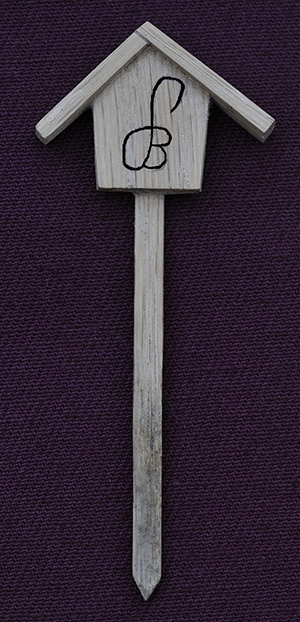
The Old Man, signing off with the marker I used to identify my plants at bonsai shows.


